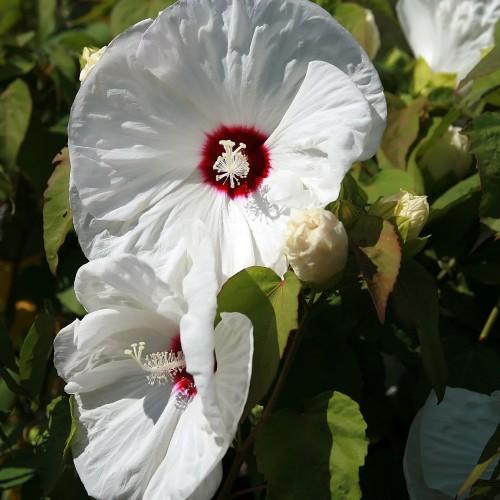
hibiscus
Hibiscus 'Old Yella'
Cycle:
Herbaceous Perennial
Watering:
Frequent
Hardiness Zone:
4 - 9
Flowers:
Flowers
Sun:
Full sun
Leaf:
Yes
Growth Rate:
High
Maintenance:
Low
Salt Tolerant:
Yes
Care Level:
Medium
watering
Hibiscus 'Old Yella' should be watered thoroughly when the top inch or 2 of soil feels dry. This species thrives best with even soil moisture, so over-watering your plant should be avoided. During the summer, this plant should be watered every other day. In the winter, however, it should be watered about once a week. Monitor soil moisture during the transitional seasons of spring and fall, as these are the times when watering needs can vary. Ensure that the container drains well, and avoid waterlogging the soil. Take precautions to avoid leaf burn and lower leaf yellowing.
sunlight
Hibiscus 'Old Yella' prefers about 6 to 8 hours of direct sunlight each day. This plant should be placed in sunny spots that receive sun during the morning and afternoon. If possible, it should be moved to a shady spot during the hottest part of the day, such as the late afternoon or evening. The sunnier the spot, the more vibrant the plant's yellow blooms will be. Furthermore, it is important to keep in mind that windy spots can cause damage to the delicate blossoms and leaves, so it's best to choose a more protected and sheltered location for this plant.
pruning
Pruning your Hibiscus 'Old Yella' is an important part of keeping it healthy and blooming. Prune your plant in late winter or early spring when the plant is resting. Remove any dead, damaged, or diseased wood. Then remove around 1 third of the oldest stems at the base of the plant, followed by any unnecessarily long stems. This will promote new growth and maintain a compact and healthy shape. In late summer, prune lightly by pinching off the tips of the stems, which will encourage new growth and prevent it from becoming leggy. When pruning, make sure you use sharp, sterilized tools to prevent infection.
Season
Hardiness Map
FAQ
Are Hibiscus flowers sensitive to touch?
Yes, Hibiscus flowers are sensitive to touch. Their delicate petals are easily disturbed and can bruise or tear if touched too roughly. They respond best to gentle handling when it involves being moved to a new location or during care, such as watering and pruning. When handling a Hibiscus, it’s best to use caution and to treat the flower with respect to prevent bruising or breakage.
Should Hibiscus plants be grown indoors or outdoors?
Hibiscus plants can be grown both indoors and outdoors. If grown indoors, they will need bright, indirect light and a warm, humid environment. Make sure they get plenty of sunlight and water, as they are tropical plants and tend to have higher humidity and water needs. When grown outdoors, make sure they are planted in a spot that has plenty of sunlight and well-drained soil. They need a minimum of six hours of direct sunlight each day and regular watering for best performance.
Could Hibiscus be propagated by stem cuttings?
Yes, hibiscus can be propagated by stem cuttings. To propagate by stem cuttings, take a cutting from a healthy stem that's at least 6 inches long and has 3-4 healthy leaves. Dip the stem cutting in rooting hormone to encourage better rooting and then insert it into a pot filled with moist soil. Keep the newly planted cutting consistently moist to encourage root growth and within a few weeks, new growth should appear!
Could Hibiscus be propagated by stem cuttings?
Yes, Hibiscus can be propagated by stem cuttings. Beginning in the summer, take 8-10 inch long cuttings from the ends of a healthy Hibiscus plant. Make sure your cuttings come from non-flowering stems and cut just below a node, which is a point where the leaf bud connects with the stem. Place your cuttings in a shallow container filled with water and place them in a sunny spot. Change the water in the container every other day and in a few weeks, roots should form. Once you notice small yellow leaves appearing at the top of the stalks, you can transfer the cutting to well-draining soil. With proper care and maintenance, your Hibiscus propagated using stem cuttings will soon begin to flower.
Do Hibiscus flowers have a short blooming period?
Yes, hibiscus flowers have a short blooming period. Generally, hibiscus flowers only last for about one day, depending on the climate and care for the plant. To ensure long-lasting color and fragrance, it is best to keep the flower in a warm and sunny spot, water it regularly, and deadhead it to encourage continuous blooms. Proper care and pruning techniques help hibiscus plants to bloom up to 7 or 8 months each year in some climates.
